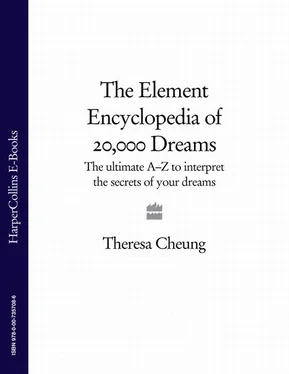Jungian constructs
The Persona
In your dreams are you wearing a disguise or mask? Are you a regal personaor did you become a superhero? Are you using cosmetics or wearing a wig? Are you worried about your appearancein some way? Are you naked? Are your clothes torn and ragged? If so, this kind of dream concerns your persona or personas, as we all have more than one.
The persona represents your public image, the part of yourself that is presented externally by what you say, wear and look like. The word is obviously related to the words ‘person’ and ‘personality’, and comes from the Latin word for mask. So the persona is the mask you put on before you show yourself to the outside world.
Your persona’s wardrobe of masks comprises the various faces you use to present yourself to different audiences in waking life—for example, your family, friends, colleagues and strangers. We wear these masks to help us relate better to different groups of people, but these masks are not the real you. Depending on the context of your dream and how you felt, your unconscious may be warning you that one of your personas is in conflict with your true self, or that you need to adopt a different persona to achieve your goals.
The persona is rarely personified in a dream. It is usually a dream theme, rather than a dream figure: for example, the persona can be said to be present in a dream in which your clothes are stained, or you are naked or inappropriately dressed. At its best, the persona is just the ‘good impression’ you wish to present as you fill the roles society requires of you. But, of course, it can also be the ‘false impression’ you use to manipulate people’s opinions and behaviors. And, at its worst, it can be mistaken, even by yourself, for your own true nature; sometimes we believe we really are what we pretend to be!
The Anima and the Animus
A part of our persona is the role of male or female we must play. For most people, that gender role is determined by their physical sex. But Jung, like Freud and Adler and others, felt that we are all really bisexual in nature. When we begin our lives in the womb, we have undifferentiated sex organs that only gradually become male or female, under the influence of hormones. Likewise, when we begin our social lives as infants, we are neither male nor female in the social sense until society molds us into men or women.
In all societies, the expectations placed on men and women differ, but in our society today, we have many remnants of traditional expectations. Women are still expected to be homemakers and nurturers; men are still expected to be strong breadwinners. But Jung felt these expectations meant that we had developed only half of our potential.
The anima is the unconscious female aspect present in the collective unconscious of men, and the animus is the unconscious male aspect present in the collective unconscious of women. The function of the anima/animus is to help the dreamer establish a good working relationship with his or her male/female counterpart. This is an important step in the development of the personality.
The anima or animus is the archetype through which you communicate with the collective unconscious generally, and it is important to get into touch with it. It is also the archetype that some researchers believe guides our choice of partner. We are, as suggested by an ancient Greek myth popularized by Plato in the Symposium , always looking for our other half—the half that the Gods took from us—in members of the opposite sex. When we fall in love at first sight, then we have found someone that ‘fills’ our anima or animus archetype particularly well!
If someone of the opposite sex played a leading role in your dreams or aroused feelings of deep yearning, attraction and fascination, then your dreaming self has witnessed the appearance of the anima/animus, the opposite of your conscious personality. This is why if you are an indecisive, shy man your animus may take the form of a party-loving woman who is resolute—or if you are a cautious, rational female your anima may take the form of a spontaneous, passionate man. The anima/animus may be either positive or negative and both can be symbolized by people you know or don’t know in waking life, as well as mythical, symbolic, and legendary characters, or by objects that somehow represent the masculine or feminine to you. Typically, the anima is personified as a single figure image; for example, a young girl, a witch, or an earth mother. It is likely to be associated with deep emotionality and the force of life itself. The animus may be a plurality of figures, for example a band of robbers or a council passing judgment, although it is also often personified as a wise old man. It is likely to be presented as logical, rationalistic, and judgmental.
By introducing the anima/animus, your unconscious is urging you to seek balance and compensate for those attitudes or behaviors that dominate your thinking and being in waking life. Heeding the promptings of your anima/animus can help you become a more content and rounded personality, and perhaps strengthen your relationships with the opposite sex
The self
The most important archetype of all is the self—the higher, more spiritual aspect of the personality. In dreams it can appear in many forms; most typically as a child or baby, suggesting vulnerability, freshness, spontaneity and potential. It can also be symbolized by the circle, the cross, and the mandala figuresthat Jung was fond of painting. (See SYMBOLS.) To a woman, the self may also be presented as a wise old woman, priestess, fairy godmother, biological mother, queen or princess. To a man, the self may manifest as a king, priest, wise old man, guru, prophet or philosopher.
The shadow
Did you dream of someone, perhaps a stranger, or someone you know who behaved in a repulsive, hateful or shocking wayand your instinctual response was one of loathing? If so, you may have encountered your shadow. In waking life, your consciousness represses your shadow, but in dreams it can come to the fore. A useful indicator of your shadow is the quality you despise most in other people, such as boastfulness or cowardice. When your shadow appears, it may be telling you to embrace that part of yourself you find hard to accept, so that you can enhance your creativity.
The shadow is the unacceptable or unknown aspect of ourselves. It derives from our pre-human, animal past, when our concerns were limited to survival and reproduction, and when we weren’t self-conscious.
Symbols of the shadow include the snake, the dragon, monsters, and demons. It can appear in many different dream disguises: a foreigner, gypsy, tramp, prostitute, murderer, thief, stranger, alcoholic, drug addict, rapist, burglar, crippled, deformed, blind, a servant or someone following you. It often guards the entrance to a cave or a pool of water, which is the collective unconscious.
The shadow is not always represented as an enemy in dreams. It often contains values that are needed by consciousness and only becomes hostile when ignored or misunderstood. Although it suggests the ‘dark side’ of the ego, the shadow is actually amoral—neither good nor bad, just like animals. An animal is capable of tender care for its young and vicious killing for food, but it doesn’t choose to do either. It just does what it does. It is ‘innocent’. But from our human perspective, the animal world looks rather brutal, inhuman, so the shadow becomes the part of ourselves that we can’t quite admit to.
Читать дальше


![Theresa Cheung - The Dream Dictionary from A to Z [Revised edition]](/books/618735/theresa-cheung-the-dream-dictionary-from-a-to-z-r-thumb.webp)
![Theresa Cheung - The Dream Dictionary from A to Z [Revised edition] - The Ultimate A–Z to Interpret the Secrets of Your Dreams](/books/692092/theresa-cheung-the-dream-dictionary-from-a-to-z-r-thumb.webp)








